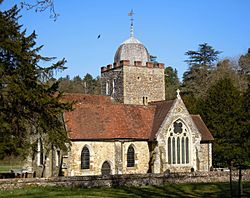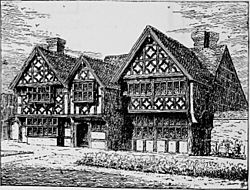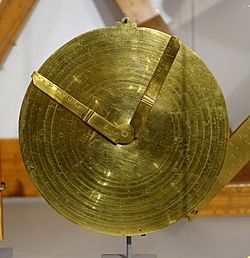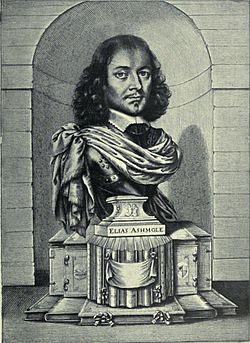William Oughtred facts for kids
Quick facts for kids
William Oughtred
|
|
|---|---|

William Oughtred engraving by Wenceslaus Hollar
|
|
| Born | 5 March 1574 |
| Died | 30 June 1660 (aged 86) Albury, Surrey, England
|
| Education | Eton College |
| Alma mater | King's College, Cambridge |
| Known for | |
| Scientific career | |
| Fields | Mathematician |
| Institutions | King's College, Cambridge |
| Notable students |
|
William Oughtred (born March 5, 1574 – died June 30, 1660) was an English mathematician and a clergyman in the Church of England. He is famous for inventing the slide rule around 1622. This tool made multiplication and division much easier. Oughtred also introduced the "×" symbol for multiplication. He also gave us the short forms "sin" and "cos" for the sine and cosine functions used in mathematics.
Contents
Life as a Clergyman
Early Education
William Oughtred was born in Eton, England, on March 5, 1574. His father, Benjamin Oughtred, was a writing teacher at Eton College, where William also studied. William loved mathematics and often stayed up late to learn more about it.
He later went to King's College, Cambridge. He earned his first degree in 1597 and a master's degree in 1600. He was a fellow at the college for several years.
Serving as a Rector
Around 1603, William Oughtred became a priest. He served as the rector (a type of church leader) at St. Mary's Church in Guildford, Surrey. In 1605, he became the vicar at Shalford, a nearby village.
In 1606, Oughtred married Christsgift Caryll in Shalford. They had twelve children together. Two of their sons, Benjamin and John, became watchmakers, following their father's interest in tools and instruments.
In 1610, Oughtred moved to Albury, Surrey, where he became the rector. He stayed in this role for fifty years until his death. He was a strong supporter of the King. It is said that he died of joy in 1660 when he heard that King Charles II had returned to the throne. He was buried in the Old St. Peter and St. Paul's Church in Albury.

Mathematician and Teacher
Oughtred was interested in mathematics from a young age. He spent all his free time studying it. When he was 23, he invented a way to draw sundials on any surface. He was always looking for better ways to measure time and solve math problems.
In 1618, Oughtred met other famous mathematicians like Henry Briggs and Edmund Gunter. He showed them his "Horizontall Instrument," which was a type of sundial.
Oughtred taught mathematics for free to many students. His teaching helped a whole generation of mathematicians. Some of his famous students included John Wallis and Christopher Wren. Even Isaac Newton thought highly of Oughtred, calling him "a Man whose judgement (if any man's) may safely be relyed upon."
Inventions
Slide Rule
Oughtred's most famous invention is the slide rule. Before him, mathematicians like Gunter used a single rule with dividers to measure distances. Oughtred made it simpler by using two rules that slid past each other. This allowed for direct multiplication and division. His first design in the 1620s was a circular slide rule. The more common linear slide rule, with a sliding middle section, came later in the 1650s.
Double Horizontal Sundial
When he was 23, Oughtred invented the double horizontal sundial. This type of sundial is now named after him. A short book describing its use was added to a math puzzle book in 1653.
Universal Equinoctial Ring Dial
Oughtred also invented the Universal equinoctial ring dial. This was another type of sundial used for telling time.
Other Interests
People at the time said that Oughtred was also interested in alchemy and astrology. These were common interests for scientists during his era. He knew famous astrologers like William Lilly.
The writer John Aubrey mentioned that Oughtred was good at natal astrology, which is predicting things based on when someone is born. Aubrey also said that Oughtred believed he sometimes got sudden ideas or solutions to problems as if by "divine genius."
Oughtred was also friends with Elias Ashmole, a famous antiquarian and alchemist. Ashmole lived near Oughtred for several years.
Oughtred Society
William Oughtred's name is remembered today by the Oughtred Society. This group was started in the United States in 1991. It is for people who collect slide rules. The society publishes a journal and holds meetings for its members.
See also
 In Spanish: William Oughtred para niños
In Spanish: William Oughtred para niños




